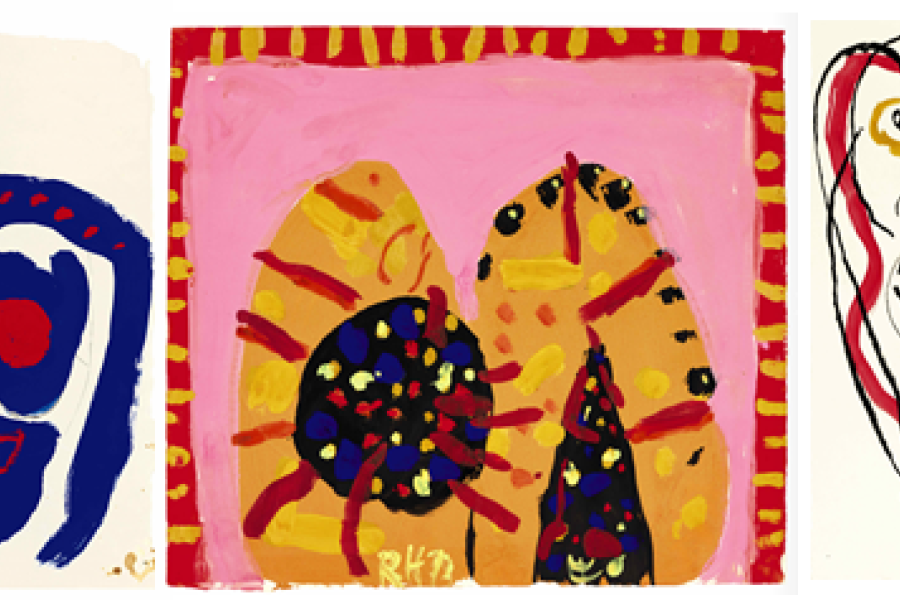May 2019, London: From 6 June to 4 July 2019, Sotheby’s S|2 gallery will present an exhibition of never-before-seen works charting the final years of Roger Hilton’s pioneering, and provocative, career. Presented in collaboration with Jonathan Clark Fine Art and co-curated by Kenny Schachter, the exhibition will showcase approximately 100 newly unearthed works on paper, painted from the confines of the artist’s bed between 1973 and 1974, and will be accompanied by the publication of a new artist monograph.Speaking about the show in his accompanying catalogue essay, art world commentator and exhibition co-curator Kenny Schachter explains: “Hilton’s drawings were composed with an economy of line and means—there were no bells or whistles (few big flashy canvases, for instance).Yet, Hilton’s last body of work, on intimately scaled sheets of paper, were fresh, inventive and expressed an exuberance beyond the life lived by the artist. I love and am touched by Roger Hilton’s art—not enough people know about it, but they should.”Following his return home from the Second World War, Hilton mastered a new, avant-garde style of abstract work which propelled him to the forefront of the British art scene. Rendered with gestural and lively brushwork, his style appealed unreservedly to the contemporary taste and cemented his reputation among the most experimental and innovative British artists of the fifties and sixties. When, in 1965, Hilton settled in St. Ives with artist Rose Hilton, he became a prominent and internationally recognised member of the St. Ives School. It was at this time that Hilton began to look beyond abstraction, incorporating hints of landscape and figuration into his work.‘One time I was one of the most extreme abstract painters. 1954, then I veered slightly.’
By 1973 Hilton was incapacitated - a physical and psychological debilitation brought on, in part, by alcoholism. Confined to his bed and unable to paint with oils, Hilton’s work underwent an abrupt change of style, defined by colourful figuration in gouache. It is this final body of work, born from the bed-ridden final years of the artist’s life, which will define S|2’s forthcoming show.
“You have to be pretty witty with poster paints, if they are not to become inert; the new paintings (started in December 1972) are almost pointillist in their complexity, to overcome the natural inertia of poster paints. I have reached a stage now of simplifying.”
Hilton’s late gouaches, endowed with an intoxicating sense of freedom and irresponsibility, immortalise his imperfect, intemperate response to the world. Sometimes bright and breezy, at other times dark and ominous, Hilton reserved the right to draw whatever observations he liked, whenever he wanted. An examination of this previously unknown cache of work reveals the artist’s preoccupations with mortality, as well as his attempts to re-visit his earlier abstract achievements and test them against his new simplicities of manner and technique.
Looking back on this time, Rose Hilton recalled: “It was during the last three years of his life that Roger created these strong, beautiful works, and also, I sensed, came to terms with some deeply spiritual convictions about death”. Hilton painted his last gouaches in early 1975, before passing away at home on 23 February, a month short of his 64th birthday.
 6 June to 4 July 2019, Sotheby’s S|2 gallery will present an exhibition. - Mit freundlicher Genehmigung von: sothebys.com
6 June to 4 July 2019, Sotheby’s S|2 gallery will present an exhibition. - Mit freundlicher Genehmigung von: sothebys.com 6 June to 4 July 2019, Sotheby’s S|2 gallery will present an exhibition. - Mit freundlicher Genehmigung von: sothebys.com
6 June to 4 July 2019, Sotheby’s S|2 gallery will present an exhibition. - Mit freundlicher Genehmigung von: sothebys.com